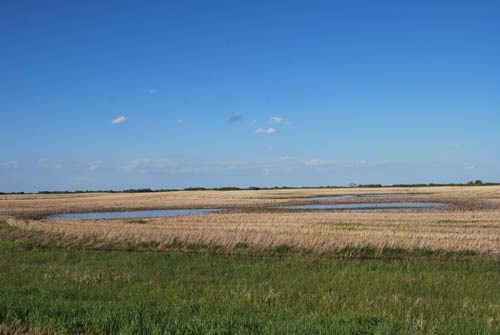With spring seeding almost at a stand-still due to weather, producers are wondering what will come as the crop insurance deadline approaches and much of the land in the area is left to be seeded.
According to the Government of Saskatchewan, 70 per cent of the 2011 crop had been seeded as of June 1. This is substantially higher than one year ago, when the province of Saskatchewan had less than 60 per cent seeded at this same time.
While the outlook for Saskatchewan is comparable to the 5-year-average of 81 per cent seeded, the south-eastern region tells a very different story. While the western and northern regions made considerable progress during the past weeks, producers in the southern and eastern regions continue to struggle to get a crop in.
The southeast region is reporting a dismal 32 per cent of cropland seeded that has resulted from very wet soil conditions and flooding. Since April 1, many areas have recorded over eight inches of rain, with some areas reporting over 10 inches. Crop reporters are predicting that there will be significant areas that go unseeded this year.
The Saskatchewan government expects farmers to continue to face challenges with spring seeding. "The majority of the producers in the region continue to struggle with wet and flooded conditions. Access to fields is a major issue as roads are washed out, flooded, or very soft. Crop reporters have indicated that some farmers are trying alternative seeding methods, such as broadcast and harrow." Some producers are changing their seeding intentions altogether. "Crop reporters are predicting there will be a shift to oats, barley, and possibly flax if the fields dry up enough in time to put the crop in." Mostly canola and wheat have been seeded at this point.
Premier Brad Wall said "We are going to have to react to that. We are going to have to look at agriculture. We are past the point. As you heard them say, especially with the last rain...a lot of farmers are just done. There will be hundreds of thousands of unseeded acres."
The government is working to address this issue as the impacts are detrimental to producers and their livelihoods. "We have increased the coverage of crop insurance. In this last budget, we actually went from 50 dollars per unseeded acres to 70 dollars per unseeded acre. The question here today was is there more. So we will be taking that back with us to further discuss" said Premier Wall.
Saskatchewan Crop Insurance confirmed this. "In 2011, the Unseeded Acreage Benefit will increase from $50 to $70 per eligible acre. The seeding intensity calculation has also been revised to help producers facing excess moisture challenges."
Additionally, the Saskatchewan Crop Insurance Corporation extended seeding deadlines. "For areas with longer growing seasons, including Kindersley, Rosetown, Leader, Swift Current, Moose Jaw and Estevan, Crop Insurance customers will now be able to seed and insure most crops until June 20. In the rest of the province, Crop Insurance customers will now have insurance on any crop seeded by June 15, other than barley, oats, mustard, peas and polish canola which can now be seeded and insured up to June 20."
If Crop Insurance customers are still unable to seed by the new deadlines due to excess moisture, they can access their Unseeded Acreage Benefit as of June 20. "In areas with extreme moisture where land will not be in a condition to seed, producers can register Unseeded Acreage claims as of June 15. The Unseeded Acreage Payment provides $70 per acre, less seeding and insurance intensities and a five per cent deductible."
Additionally, the Premier stated that "Technically the way the program was, if you had land that you could seed, even if you couldn't get to it, sometimes you had seedable acreage...And technically, that wouldn't have been eligible for the $70 per acreage and we changed that today. If you can't get there, it is unseedable...and that is whether it is dry or wet." That change means that producers who are unable to seed because of impassable roads caused by excess moisture can still apply for compensation through the Unseeded Acreage Benefit. The deadline for customers to register an Unseeded Acreage claim is June 25, 2011.




